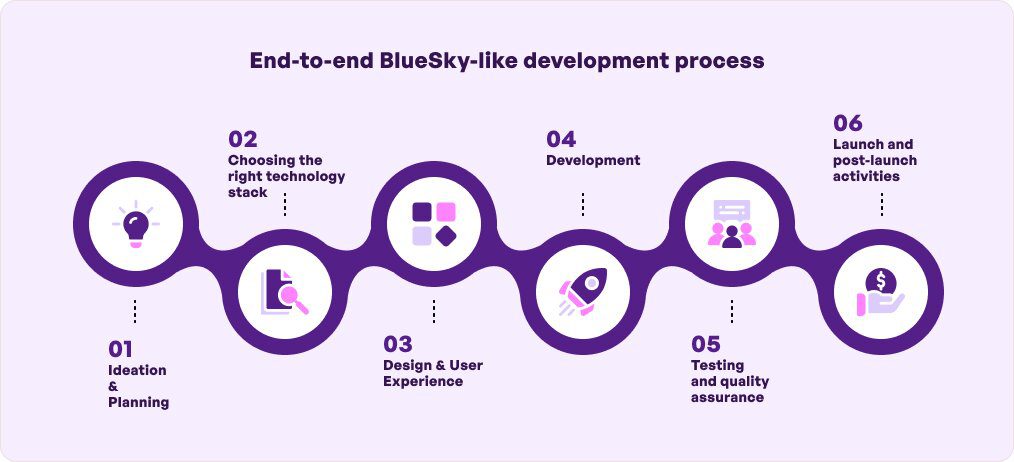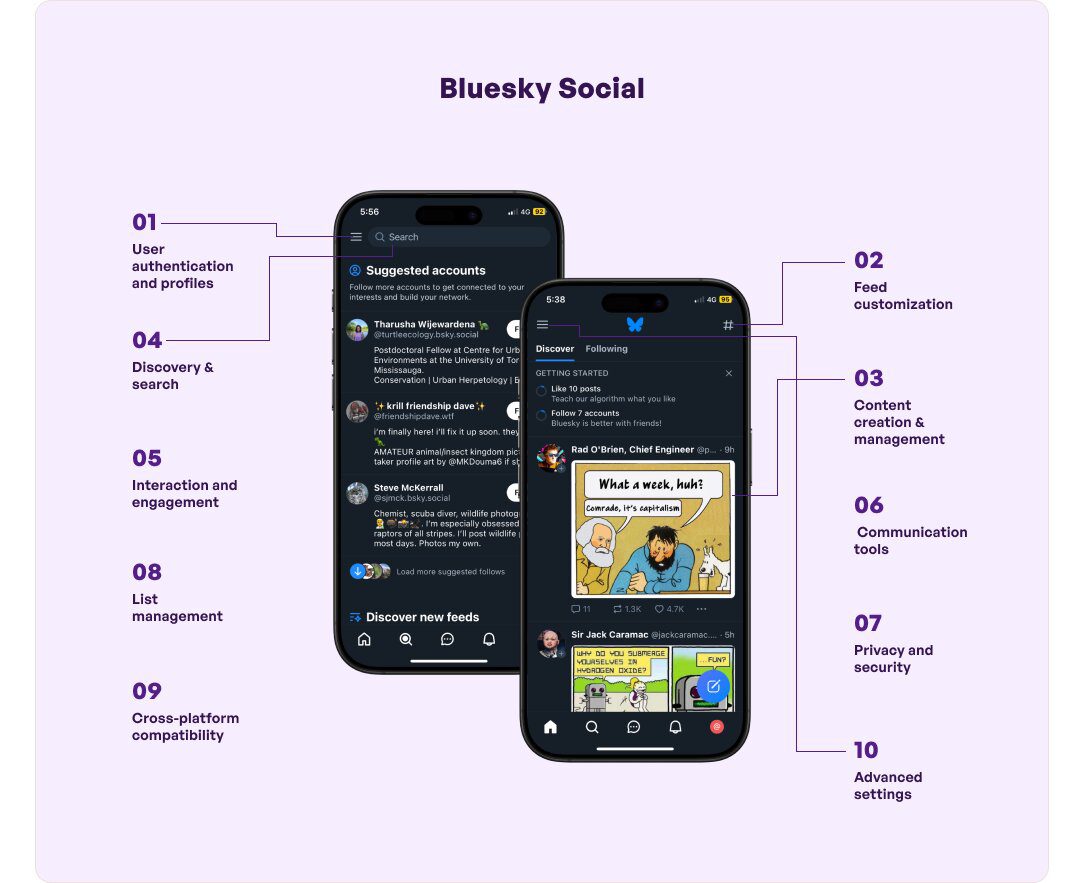X’s (ex-Twitter) misalignment with the Brazilian government led to the platform getting banned in the region – the news, which might have come as a shock to the millions of X users in the country, was a definite blessing for Bluesky. The social media platform was built on more or less the same ideologies (and uncanny UI resemblance) as Twitter rose to sudden fame post-X ban.
While it can be said that this sudden traction is nothing but coincidental, the fact that the app’s downloads in Brazil were up by a whopping 1,018,952% is nowhere close to catching a break. With more countries joining the list, it is safe to assume that the application has crossed the stage of being a fad.
For social media-invested entrepreneurs, this presents an opportunity to replicate Bluesky’s sky-rocketing growth with an app that is built to address the former’s lacks and become a new phenomenon. Something that we will discuss, through its multiple facets, in detail in this article.
Table of contents
Tracking the rise of Bluesky
In the aftermath of Twitter’s ban in Brazil, the number of likes on the Bluesky social network grew to 104.6 million, up from 13 million when compared. The followers also grew from 1.4 million to 100.8 million while the reposts on the app grew from 1.3 million to over 11 million.
Bluesky representative even said it had added new 2.11 million users during the period, up from the 26,000 users it added the week before. In addition, the brand saw “significantly more than a 100% daily active users increase.” In terms of downloads, regions that saw maximum installs outside Brazil were the U.S., Portugal, Spain, the U.K., and Canada.
The primary reason for this sudden growth can be attributed to the fact that X’s ban has been a political move – the country needed complete control of what was said on the platform. There’s a rumor that Brazilians who opted for Bluesky were looking for a network that was not centralized and could be controlled easily.
Irrespective of the reason, the undeniable fact is Bluesky is on a high-speed growth trajectory, making itself a go-to solution for social media-enthusiast entrepreneurs.
 Let’s dive into the many facets of the Bluesky-like social media app development process, looking into both technical and business aspects of creating a similar brand.
Let’s dive into the many facets of the Bluesky-like social media app development process, looking into both technical and business aspects of creating a similar brand.
The list of must-have features from Bluesky
Building an app like Bluesky requires integrating a comprehensive set of features that offer users a seamless and engaging social media experience. Below are the critical features that define Bluesky and should be considered when developing a similar platform.
- User authentication and profiles
Bluesky offers robust authentication methods, allowing users to sign up or log in using email, social accounts, or decentralized identifiers (DIDs). Each user can create a personalized profile, complete with a bio, profile picture, and other personal details, enhancing the sense of community and personal connection on the platform.
- Feed customization
One of the key features of Bluesky app is its customizable feeds. Users have the power to tailor their content consumption by creating personalized feeds based on specific interests or communities. This customization extends to the ability to control the algorithms that influence the content displayed, making the experience truly user-centric.
- Content creation and management
Bluesky facilitates diverse content creation, allowing users to post text, images, and videos. Users can manage their content effectively through editing, deleting, or archiving posts. Additionally, unique features like the ability to enable or disable quote posts per individual post give users more control over how their content is interacted with.
- Discovery and search
To keep the community vibrant and connected, Bluesky app features include a robust discovery section where users can explore trending topics, and popular posts, and discover new users. The advanced search functionality enables users to find specific content, people, or topics with ease, making the platform intuitive and engaging.
- Interaction and engagement
Engagement lies at the heart of Bluesky. Users can interact through likes, comments, and shares, fostering a lively and interactive community. Real-time notifications ensure users stay updated on new interactions, such as likes, comments, mentions, and follows, keeping them engaged with the platform.
- Communication tools
Bluesky enhances social connections with direct messaging features, allowing for private conversations between users. The app also supports group chats, providing a collaborative space for users to engage in discussions with multiple participants.
- Privacy and security
Privacy and security are prioritized, with Bluesky app features allowing users to block or report accounts that breach community guidelines. Users also have access to content moderation tools, which enable them to filter or hide specific content types, ensuring a safe and enjoyable user experience.
- List management
To help users organize their interactions, Bluesky offers custom lists. These lists enable users to categorize and manage other profiles, streamlining their social media management and helping them stay connected with preferred content sources.
- Cross-platform compatibility
Bluesky is designed to be accessible across multiple devices, with full functionality on both mobile apps and web interfaces. This cross-platform compatibility ensures that users can stay connected anytime, anywhere.
- Advanced settings
Users have access to a wide range of settings that provide control over their notifications, privacy, and data-sharing preferences. These advanced settings allow users to tailor their experience to suit their needs, enhancing overall satisfaction with the platform.
 These features not only make Bluesky a powerful alternative to traditional social networks but also set a standard for building modern, user-focused social media app development. By integrating similar functionalities, you can also create a platform that resonates with users seeking a more controlled and personalized social media experience.
These features not only make Bluesky a powerful alternative to traditional social networks but also set a standard for building modern, user-focused social media app development. By integrating similar functionalities, you can also create a platform that resonates with users seeking a more controlled and personalized social media experience.
Now while these are the core features surrounding Bluesky-like app development, some advance elements make the platform truly unique.
- Decentralized architecture: Bluesky uses the AT Protocol, which promotes decentralization by allowing different social apps to interconnect, providing users more control over their data and content.
- Customizable feeds: Users can create custom feeds tailored to specific topics or communities, enhancing content personalization and user engagement.
- Advanced moderation tools: Bluesky provides personal moderation controls, allowing users to filter content and manage their social experience according to their preferences.
- Open APIs for developers: The platform offers open APIs, enabling developers to build custom clients, bots, or features. This open approach encourages innovation and expands the app’s ecosystem by allowing third-party developers to create compatible applications.
- User identity management: Bluesky uses DID (Decentralized Identifier) technology for unique user profiles, ensuring secure and portable identities across different apps on the network.
- Comprehensive SDKs: Bluesky provides SDKs in multiple languages (TypeScript, Python, Dart, etc.), making it easier for developers to integrate and build upon the platform.
- Quote post options: Users can toggle the ability for others to quote their posts, offering a nuanced approach to engagement and interaction control.
- Interoperability with other platforms: The platform’s design emphasizes interoperability, allowing content and interactions to extend beyond Bluesky’s own environment, which can appeal to users looking for a more integrated social media experience.
End-to-end Bluesky-like development process
When you build an app like Bluesky, the process involves several critical stages, each requiring careful planning, expert execution, and a clear understanding of decentralized social media dynamics. The stages ensure that the final product is not only functional but also scalable and user-friendly. Below, we outline the key steps involved in bringing a Bluesky-like app to life, highlighting best practices and important considerations at each stage.

Ideation and planning
- Define the vision: Start by defining the core vision of your app. What makes your platform unique? Who is your target audience? This stage should involve a deep-level market research, identification of key features, and setting up of clear objectives for the mobile app.
- Set goals and milestones: Establish project goals and key milestones. This includes creating a project roadmap that outlines timelines, deliverables, and budget estimates.
- Risk assessment: Identify potential risks and issues proactively. Based on these assessments, develop strategies to mitigate these risks, ensuring a smoother development journey.
Choosing the right technology stack
- Select the core technologies: For a decentralized app, choosing the right technology stack is crucial. When you build an app like Bluesky, consider using blockchain or AT Protocol for decentralization, along with robust backend technologies like Node.js, Python, or Go.
- Frontend frameworks: Opt for modern frontend frameworks like React, Vue.js, or Angular to ensure a responsive and dynamic user interface.
- Scalability and security: Focus on technologies that support scalability and provide robust security measures to protect user data and maintain the app’s integrity.
Design and user experience
- UI/UX design: Invest in creating a visually appealing and intuitive design. Conduct user experience research to understand user needs and preferences, and use these insights to inform your design decisions.
- Prototype and feedback: Develop interactive prototypes and gather feedback from potential users. Iteratively refine the design based on this feedback to enhance usability.
- Branding and consistency: Ensure that the design aligns with your brand identity and provides a consistent experience across all user touchpoints.
Development
- Backend development: Focus on developing a strong backend architecture that supports the core functionalities of your app, including user management, data storage, and content delivery.
- Frontend development: Implement the user interface as per the designs, ensuring it is fully responsive and accessible across various devices.
- Integration: Integrate APIs, third-party services, and the selected protocol for decentralization. Ensure seamless connectivity between the backend and frontend components.
Testing and quality assurance
- Functional testing: Conduct thorough testing to ensure that all features work as intended. This can include a series of tests like – unit tests, integration tests, and system tests.
- Performance testing: Test the app for speed, scalability, and load-handling capabilities. Ensure that the app performs optimally under various conditions.
- Security testing: Perform security audits to identify and fix vulnerabilities, protecting the app from potential threats.
Launch and post-launch activities
- Deployment: Deploy the app to a live environment, ensuring that all configurations are optimized for production.
- Monitoring and maintenance: Set up monitoring tools to track app performance, user behavior, and potential issues. Post this, a regular maintenance and updates will be essential to keep the app running smoothly.
- User feedback and iteration: Collect user feedback post-launch to identify areas for improvement. Continuously iterate on the app, adding new features and enhancements based on user needs.
 Now that we have looked into the process of how to create a social media app like Bluesky, the features to focus on, and the ones to look out for that make Bluesky a unique product, the next part of the decision-making process for entrepreneurs would be to know the cost.
Now that we have looked into the process of how to create a social media app like Bluesky, the features to focus on, and the ones to look out for that make Bluesky a unique product, the next part of the decision-making process for entrepreneurs would be to know the cost.
The cost breakdown for building a Bluesky-like app
Developing a Bluesky-like app involves several cost components that need to be carefully considered to ensure a balanced budget and successful project delivery. The overall cost can vary significantly based on factors such as the app’s complexity, the technology stack chosen, the location of the development team, and the scope of features required. Below is a detailed cost breakdown with estimated numbers for each development stage:
- Planning and Ideation: This initial stage includes market research, defining the app’s vision, and setting project goals. While it may seem like a small portion of the budget, investing in thorough planning can save costs in later stages by clearly outlining the app’s direction and avoiding scope creep. Typically, this phase accounts for about 5-10% of the total project cost. Estimated cost: $5,000 – $10,000.
- Design and user experience: The design phase encompasses creating the user interface (UI) and user experience (UX) designs, which are crucial for the app’s appeal and usability. Costs here can vary depending on the complexity of the design and the level of detail required, including branding and interactive elements. Expect this to represent around 15-20% of the total budget, as high-quality design not only attracts users but also improves engagement and retention rates. Estimated cost: $15,000 – $25,000.
- Development: Development is usually the most significant cost component, covering both backend and frontend development. The backend involves building the app’s core architecture, including database management, user authentication, and server-side functions, while the front end focuses on implementing the user interface according to the design specifications. Costs can range widely depending on the chosen technology stack, the number of integrations needed, and the complexity of the features, making up approximately 40-50% of the total cost. Estimated cost: $50,000 – $100,000.
- Testing and quality assurance: Testing ensures that all app features work as intended and that the app performs well under different conditions. This phase includes functional testing, performance testing, and security testing, each critical to launching a reliable and secure app. Quality assurance typically accounts for 10-15% of the overall budget, with more complex apps requiring extensive testing to meet high user expectations. Estimated cost: $10,000 – $20,000.
- Deployment and launch: The deployment phase involves pushing the app live to platforms such as the App Store or Google Play, which may include costs for app store fees and initial marketing to promote the launch. This stage is relatively smaller in cost, usually around 5% of the budget, but it’s crucial for a smooth go-live process and initial user acquisition. Estimated cost: $5,000 – $10,000.
- Post-launch support and maintenance: After launch, ongoing support and maintenance are necessary to keep the app updated with new features, security patches, and performance improvements. This is an ongoing expense, typically calculated as a percentage of the initial development cost, often ranging from 10-20% annually. Investing in regular updates and improvements helps maintain user satisfaction and keeps the app competitive in a fast-evolving market. Estimated annual cost: $10,000 – $20,000.
 As you can see, the Bluesky-like social media app development cost can be pretty extensive and with a competitor getting massive tractions from the industry, how can you ensure that your version gets maximum revenue? Let’s get into that next.
As you can see, the Bluesky-like social media app development cost can be pretty extensive and with a competitor getting massive tractions from the industry, how can you ensure that your version gets maximum revenue? Let’s get into that next.
How to make a better app than Bluesky
While Bluesky offers a strong foundation as a decentralized social media platform, there are numerous opportunities to innovate and enhance the user experience to build an even more compelling app. Below are some strategic areas and features to focus on to differentiate your app and provide greater value to users:
- Enhanced privacy and data control
- User-centric privacy settings: Implement advanced privacy settings that give users complete control over their data, including detailed permissions for how their information is shared and used. Consider integrating end-to-end encryption for all communications and ensuring transparency in data policies to build trust with users.
- Decentralized identity management: Take a step further with decentralized identity management, where users can have portable identities across different platforms without compromising privacy. This can attract privacy-conscious users who seek more control over their online presence.
- Advanced AI and personalization
- AI-driven content recommendations: Use machine learning algorithms to offer highly personalized content recommendations that go beyond basic engagement metrics. By analyzing user behavior, preferences, and interactions, your app can provide a more engaging and relevant feed that keeps users coming back.
- Smart moderation tools: Implement AI-powered moderation tools that can automatically detect and filter harmful content, spam, or bots while still allowing for user input and adjustments. This keeps the platform safe and user-friendly without over-relying on manual moderation efforts.
- Unique engagement features
- Interactive Content Creation: Introduce more interactive content creation tools, such as polls, quizzes, or multimedia editing features, that allow users to express themselves in diverse ways. Providing templates or guided creation modes can also lower the barrier to content creation for all users.
- Gamification: Incorporate gamification elements like badges, rewards, or challenges to increase user engagement. Rewarding users for meaningful interactions, such as quality posts or community contributions, can foster a more active and positive community.
- Seamless cross-platform experience
- Multi-platform integration: Ensure a seamless experience across various devices and operating systems, including web, mobile, and even desktop apps. Enhancing cross-platform functionality and synchronization will provide a smoother user experience and widen your app’s accessibility.
- Third-party integrations: Allow for integrations with other popular apps and services, such as cloud storage, productivity tools, or other social networks. This can make your app a more versatile hub for users, enabling them to connect various aspects of their digital lives.
- Community and ecosystem building
- Developer-friendly environment: Encourage external developers to build on your platform by offering comprehensive APIs, SDKs, and developer support. Creating an ecosystem where developers can contribute plugins, custom feeds, or new features can drive innovation and keep the platform evolving.
- Community governance: Consider integrating community-driven governance models where users have a say in platform changes, policies, or feature prioritization. This can foster a sense of ownership and loyalty among users, making them feel like active stakeholders in the platform’s success.
- Monetization and business models
- Diverse monetization options: Explore multiple revenue streams beyond traditional advertising, such as premium subscriptions, microtransactions for exclusive content or features, and partnership opportunities with brands or content creators.
- Support for creators: Provide robust tools and monetization opportunities for content creators, such as tipping, subscription models, or in-app shops. Empowering creators to earn from their content can attract more high-quality content to your platform and foster a vibrant community.
By focusing on these areas, you can build a social media app that not only matches Bluesky’s strengths but also offers enhanced features that cater to evolving user needs and preferences. The key to getting maximum ROI on the cost to develop an app like Bluesky is to listen to your user base, stay agile with your updates, and continually look for innovative ways to differentiate your platform in a competitive market.
Where does Simublade fit in?
At Simublade, we’re dedicated to turning innovative ideas into high-impact digital experiences with our social media app development services. As an app design and development company, we excel in building decentralized platforms like Bluesky by leveraging advanced technologies such as blockchain and the AT Protocol. Our team is passionate about crafting user-centric designs that are not only visually appealing but also intuitive and functional, ensuring a seamless experience across all devices. From initial concept to final deployment, we provide end-to-end services that are customized to meet your specific business needs, helping you create an app that stands out in the market.
We believe that the success of any app lies in the details, and our meticulous mobile app development services approach to design, engineering, and ongoing support ensures that your platform not only launches successfully but continues to evolve and thrive. Whether you’re looking to build a better version of Bluesky or explore new possibilities in the social media landscape, Simublade is here to guide you every step of the way. Ready to bring your vision to life? Get in touch with us today, and let’s start building something extraordinary together.
FAQs
Q1. How long does it take to build an app like Bluesky?
Ans. The development timeline for an app like Bluesky can vary depending on factors such as the complexity of features, the size of the development team, and the level of customization required. On average, building a basic version of a decentralized social media app can take anywhere from 6 to 12 months. This includes stages like ideation, planning, design, development, testing, and deployment. More complex features or extensive customization can extend this timeline, potentially adding several months for additional testing and iterative improvements.
Q2. What are the benefits of creating an app like Bluesky?
Ans. The cost to develop an app like Bluesky can range significantly based on the scope and complexity of the project. For a basic version with core features, you might expect to invest between $80,000 to $150,000. For a more advanced app with extensive features, scalability, and high security, the cost can rise to $200,000 or more. Key cost factors include design, technology stack, backend and frontend development, testing, and post-launch support. Working with a skilled development team that understands decentralized technologies can help optimize costs while ensuring high-quality outcomes.
Q3. What technologies are required to develop a Bluesky-like app?
Ans. To build a decentralized social media app like Bluesky, you would typically use a combination of technologies that support scalability, security, and decentralization. Core technologies might include blockchain or the AT Protocol for decentralization, Node.js, Python, or Go for backend development, and modern frontend frameworks like React, Vue.js, or Angular. Additional technologies might include cloud services for hosting, API integrations for added functionality, and encryption protocols to ensure data security. The specific technology stack should be tailored to your project’s needs and long-term goals.
Q4. What are the benefits of creating an app like Bluesky?
Ans. Developing an app like Bluesky offers several benefits, including the ability to tap into the growing demand for decentralized social media platforms that prioritize user privacy and data control. Such apps empower users by giving them more control over their content and interactions, reducing the dominance of centralized platforms. Additionally, decentralized apps often foster stronger community engagement and can be more resilient against censorship. For entrepreneurs, this presents an opportunity to build a unique product that stands out in the market and meets evolving user expectations around privacy and transparency.
Q5. How does the Bluesky app ensure user data security?
Ans. Bluesky ensures user data security through several key mechanisms, including decentralized identity management and advanced encryption protocols. By leveraging decentralized technologies, Bluesky minimizes the risk of data breaches associated with centralized data storage. Additionally, the platform’s use of end-to-end encryption for communications helps protect user data from unauthorized access. Regular security audits and updates further enhance the platform’s resilience against potential threats, making it a secure choice for users who prioritize data privacy and control.




